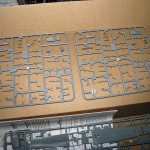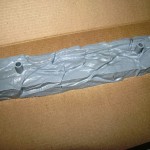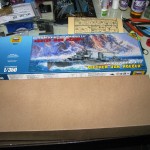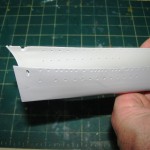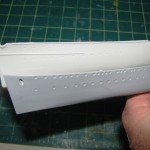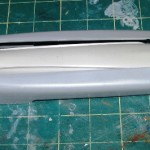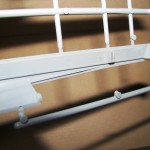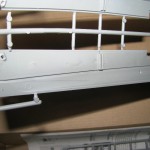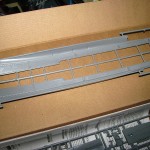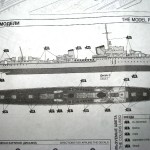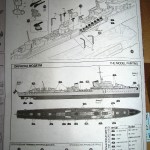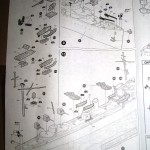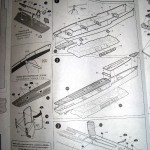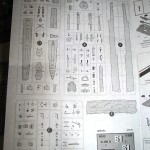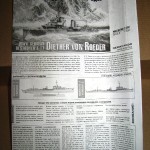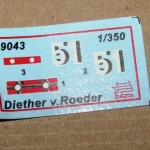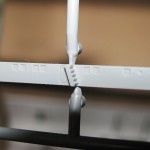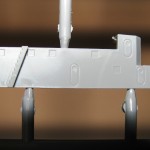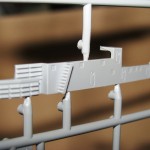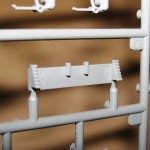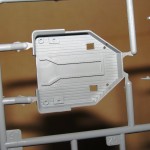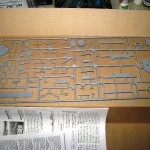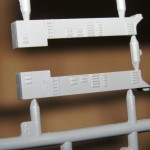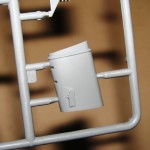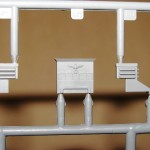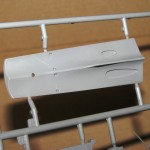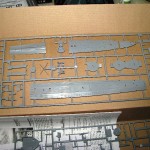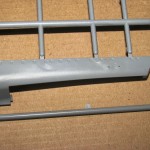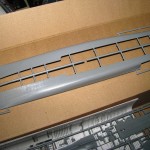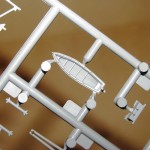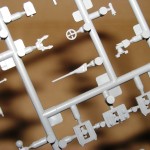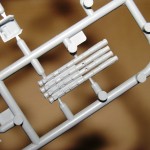Description: Injection molded plastic model
Scale: 1/350
Price: MSRP $41.95
Contents and Media: 178 injection molded parts
Advantages: Unusual subject. First release in injection molded plastic of 1936 class of destroyers; following Trumpeter and Dragons release of 1936A, 1936A (Mob) and 1936B classes.
Disadvantages: Slightly under scale, oversize port holes on hull, soft plastic and details, use of “Aztec” stairs.
Recommendation: Recommended for hard core German World War II destroyer fans. Casual ship modelers may want to stay with the Trumpeter or Dragon releases.
History (from Wikipedia):
The lead ship of the 1936 class of destroyers started the war patrolling and later laying mines along the Humber Estuary, which resulted in the sinking of seven ships.
As part of the German effort to conquer Norway, she was assigned to Operation Weserubung. She participated in both naval battles of Narvik, being damage during the first battle with Royal Navy destroyers and then being further damanged and scuttled as a result of the second battle, in which the British battleship Warspite joined the fracas.
For more information: http://en.wikipedia.org/wiki/German_destroyer_Z17_Diether_von_Roeder
The Model:
The model comes in a sturdy box with a dramatic painting on the cover of Diether Von 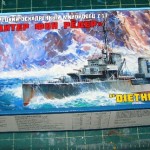 Roeder in what ismost likely a Norwegian fiord. Upon opening the box, you’ll find another cover as part of the box bottom, sort of nesting boxes. Opening this flap reveals five sprues of plastic (one with the hulls havles, then two large and two small), a stylistic stand for the model (shaped to resemble the ocean floor?), directions and a small decal sheet.
Roeder in what ismost likely a Norwegian fiord. Upon opening the box, you’ll find another cover as part of the box bottom, sort of nesting boxes. Opening this flap reveals five sprues of plastic (one with the hulls havles, then two large and two small), a stylistic stand for the model (shaped to resemble the ocean floor?), directions and a small decal sheet.
None of the sprues are labeled. The two smaller sprues are identical. They contain the main armament, AA guns, anchors, davits, ships boats, cranes and torpedo tubes. Some of the parts – like the torpedo tubes and small AA guns – are nicely done.
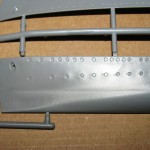 The hull comes in two halves, both on the same sprue. The length is 13 ¾ inches, which is a little short in scale. The portholes look to be WAY overscale, and you can see very small marks on the hull from the mold. Inside the hull are deep grooves to cut the hull to waterline configuration. Also, the bottom of the hull where the struts and shafts go is a separate piece located on another sprue. That is most likely going to lead to some filling and sanding if you are going the full hull option. If you are doing full hull, there are two spots to drill out for the stand to affix to the bottom. Make sure you take note of that before assembly starts!
The hull comes in two halves, both on the same sprue. The length is 13 ¾ inches, which is a little short in scale. The portholes look to be WAY overscale, and you can see very small marks on the hull from the mold. Inside the hull are deep grooves to cut the hull to waterline configuration. Also, the bottom of the hull where the struts and shafts go is a separate piece located on another sprue. That is most likely going to lead to some filling and sanding if you are going the full hull option. If you are doing full hull, there are two spots to drill out for the stand to affix to the bottom. Make sure you take note of that before assembly starts!
One of the large spures contains a name plate, superstructure bulkheads, decks, more boats and other small parts like the breakwater, struts and props, and the jack and flag staffs. The watertight doors on the bulkhead sides have the details etched it, but the doors look a little small. The good thing is you’ll be able to place any photo-etch enhancements right over them without having to scrape anything off. This is the sprue where the dreaded Aztec stairs make their first appearance. They are clunky and over scale. Why Zvezda included them is beyond me. One of the bridge platforms is also on this sprue, and I found the planking on the deck to be a bit heavy.
The second sprue contains the main deck parts, both fore and aft. The aft section contains mine rails, which stand a little proud in appearance, but they very may well be to scale. The forward section of the deck is two parts – the section for the bow is separate, 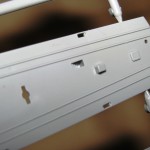 which leads me to believe there may be further releases with the more curved bow that started with Z19. Measuring the deck at its widest point, it appears that the ship is slightly narrow in scale in relation to the original.
which leads me to believe there may be further releases with the more curved bow that started with Z19. Measuring the deck at its widest point, it appears that the ship is slightly narrow in scale in relation to the original.
There are more bulkheads on this sprue, along with the funnels, decking for both the forward and the aft superstructure, some piping and parts for the masts. The forward part of the bridge has recessed windows and the German eagle adorning its front – you’ll have to remove this to portray her as during the Narvik battles, as this was most likely removed by this time. Other bulkheads again have the recessed watertight doors, in both rounded and square styles, and some molded on ladders.
The decal sheet is pedestrian, with two number “51”s for her pre-war pendant number, and two Nazi flags with no swastika, which is common for European releases.
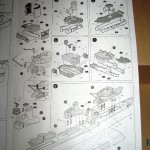 The instructions are well done, the format is similar to Trumpeters, and seem logical in their layout and progression. The color callouts are all in Humbrol paints, and are questionable, as they depict the ship on one color. Photographs clearly show these ships in a two tone scheme, most likely the standard German livery of Dunkelgrau 51 on the hull and Hellgrau 50 on the superstructure, which is how I plan to depict mine, along with the prewar pendant numbers.
The instructions are well done, the format is similar to Trumpeters, and seem logical in their layout and progression. The color callouts are all in Humbrol paints, and are questionable, as they depict the ship on one color. Photographs clearly show these ships in a two tone scheme, most likely the standard German livery of Dunkelgrau 51 on the hull and Hellgrau 50 on the superstructure, which is how I plan to depict mine, along with the prewar pendant numbers.
Conclusions:
On the plus side, we have a Type 1936 German Zerstörer in 1/350 scale! The kit – while being slightly under scale – is a good starting point to build a good representation of this important class of ships.
On the negative side, this model is soft of details – the Aztec stair and over scale portholes being a particular disappointment to this reviewer. Additionally, it an era where most manufacturers are including at least basic photo-etch in their models, this kit has none.
If this had been the first Zerstörer kit released, perhaps I wouldn’t be so disappointed in this 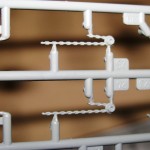 kit. However, it does not measure up to the Trumpeter releases in detail, let alone the Dragon Zerstörers.
kit. However, it does not measure up to the Trumpeter releases in detail, let alone the Dragon Zerstörers.
This kit cries out for some photo-etch, which hopefully someone will release in the near future. In the meantime, you can probably get away with using one of the Eduard sets they released for the previously released Zerstörer kits, if you can find them.
This kit is recommended for hard core German Kreigsmarine fans. If you are a casual ship modeler and want just one German Zerstörer in your collection, I recommend one of the Trumpeter or Dragon kits instead.
– Martin J. Quinn. January 2014.


